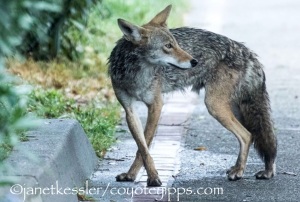- Monitoring from way above a trail
- loud, distressed barking
- vigorously scratching and pawing the ground
The morning, which ended up in such a leisurely fashion, did not begin this way. I spotted this mother coyote early on as she headed up towards a rock. She stayed up there, moving between several high rocks, and eventually sprawled out on the highest one, but she definitely was keeping her eye on something on the trail below. Then, in a flash, she dashed off. I thought that was the end of my coyote viewing for the day. Within minutes the coyote began her distressed barking — she only does this when she has been chased or interfered with by a dog — it may be one of her ways of keeping dogs at bay, but it also shows that she is upset.
It turns out that she had seen a dog, a dog she has seen often, which got too close to one of her yearling pups — she had come to its aid. The pup was probably in absolutely no danger, but we have to see it from this mother’s point of view: after all, dogs have chased her plenty of times in the past. When she first appeared on the scene, the dog, which should have been leashed, chased her off — this is normal unleashed dog behavior. But she responded by returning and coming in pretty close. This is typical coyote behavior. It can only be prevented by leashing our dogs immediately when a coyote is spotted, and not allowing a “casual” encounter — you cannot predict what will happen with any animal, much less with a wild animal, and in this case there was more than one coyote — the mother and the yearling. Keeping your dog leashed and close to yourself will serve to deter a coyote from coming in closer as you move out of the immediate vicinity.
There is usually an alpha female somewhere around in any coyote group: she is the only one that breeds and she is the one that controls the group and is responsible for their safety. If we allow our dogs to approach or threaten — or even appear to threaten a coyote — the female may come in to help so that you might be dealing with more than one coyote. Coyotes work as a team when there is more than one of them, with one serving to distract while the other goes around to approach from the other side — this usually is more than most dogs can handle — dogs feel overwhelmed by this behavior. But the coyotes are trying to send a message as clearly as they can: “Leave!” and “Don’t mess with us.” They will continue this behavior, coming back again and maybe again, until dog and owner move on out of the immediate vicinity where the dog had come too close to the yearling.
The dogs, too, may feel they need to defend “their pack”, which includes all dogs or individuals in their party. Each side — dogs and coyotes — want to feel they have “won” by making the other leave. In this incident today, once the coyotes left for the first time, the dogs thought they had “taken care of the matter”, but the coyotes returned to continue vexing the dogs and owner until they left. Only we humans can prevent these interactions from happening by leashing our dogs. It is a canine-canine thing which needs our intervention if we all want to coexist together: humans, dogs, and recently returned wildlife.
The best policy is to leash up and move on. Please read about coyote safety and how you can shoo a coyote off if you encounter one at a close enough range to make you uncomfortable: Coyote Safety published on November 3, 2009.





